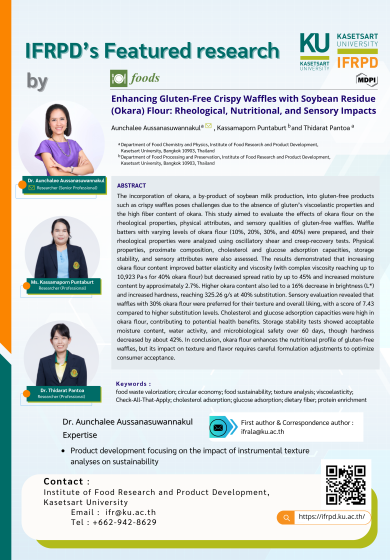| ผลงานวิจัย | ดร.อัญชลี อุษณาสุวรรณกุล และคณะ |
| Keywords | food waste valorization; circular economy; food sustainability; texture analysis; okara |
| Telephone | 0 2942 8629 (1506) |
| ifrala@ku.ac.th | |
| URL | https://doi.org/10.3390/foods13182951 |

Enhancing Gluten-Free Crispy Waffles with Soybean Residue (Okara) Flour: Rheological, Nutritional, and Sensory Impacts

| ผลงานวิจัย | ดร.อัญชลี อุษณาสุวรรณกุล และคณะ |
| Keywords | food waste valorization; circular economy; food sustainability; texture analysis; okara |
| Telephone | 0 2942 8629 (1506) |
| ifrala@ku.ac.th | |
| URL | https://doi.org/10.3390/foods13182951 |
จุดเด่นผลงาน
บทสรุป : งานวิจัยนี้ศึกษาการนำกากถั่วเหลือง (โอคารา) ซึ่งเป็นผลพลอยได้จากกระบวนการผลิตนมถั่วเหลืองมาใช้เป็นวัตถุดิบในการพัฒนาวาฟเฟิลกรอบปลอดกลูเตน ผลการศึกษาพบว่า แป้งโอคาราช่วยเพิ่มคุณค่าทางโภชนาการให้แก่ผลิตภัณฑ์ เพิ่มความคงตัวให้แก่โด และเพิ่มคุณภาพทางประสาทสัมผัสให้แก่วาฟเฟิลกรอบ งานวิจัยนี้นำเสนอแนวทางการแปรรูปอาหารอย่างยั่งยืน พร้อมประโยชน์เชิง
Abstract : The incorporation of okara, a by-product of soybean milk production, into gluten-free products such as crispy waffles poses challenges due to the absence of gluten’s viscoelastic properties and the high fiber content of okara. This study aimed to evaluate the effects of okara flour on the rheological properties, physical attributes, and sensory qualities of gluten-free waffles. Waffle batters with varying levels of okara flour (10%, 20%, 30%, and 40%) were prepared, and their rheological properties were analyzed using oscillatory shear and creep-recovery tests. Physical properties, proximate composition, cholesterol and glucose adsorption capacities, storage stability, and sensory attributes were also assessed. The results demonstrated that increasing okara flour content improved batter elasticity and viscosity (with complex viscosity reaching up to 10,923 Pa·s for 40% okara flour) but decreased spread ratio by up to 45% and increased moisture content by approximately 2.7%. Higher okara content also led to a 16% decrease in brightness (L*) and increased hardness, reaching 325.26 g/s at 40% substitution. Sensory evaluation revealed that waffles with 30% okara flour were preferred for their texture and overall liking, with a score of 7.43 compared to higher substitution levels. Cholesterol and glucose adsorption capacities were high in okara flour, contributing to potential health benefits. Storage stability tests showed acceptable moisture content, water activity, and microbiological safety over 60 days, though hardness decreased by about 42%. In conclusion, okara flour enhances the nutritional profile of gluten-free waffles, but its impact on texture and flavor requires careful formulation adjustments to optimize consumer acceptance.
Foods 2024, 13(18), 2951